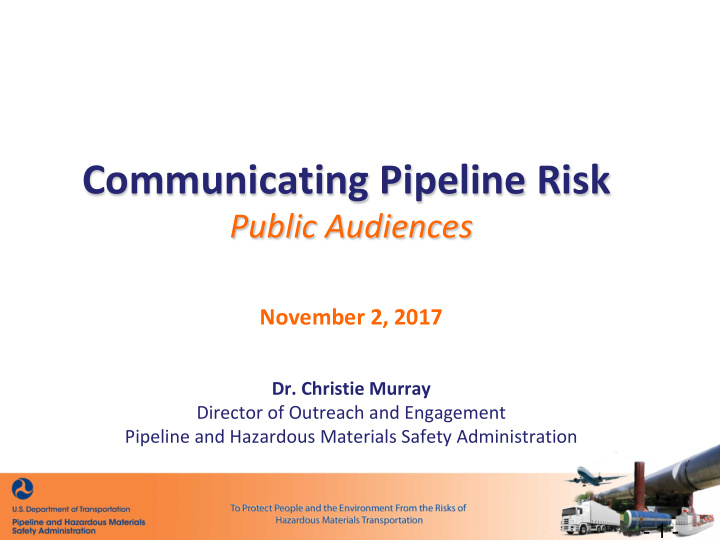



Communicating Pipeline Risk Public Audiences November 2, 2017 Dr. Christie Murray Director of Outreach and Engagement Pipeline and Hazardous Materials Safety Administration - 1 -
Pipeline Safety Office of Outreach and Engagement • Damage Prevention (811/Excavator Enforcement) • National Pipeline Mapping System • Pipeline Emergency Response Initiative (PERI) • Pipeline and Informed Planning Alliance Outreach • Community Liaison Program (Technical Assistance) • Grant Programs – State Damage Prevention – Technical Assistance Grant • Public Awareness 2
Pipeline Public Awareness Outreach Operators Messages Evaluate Assess Operator and Program Regulatory Develops & Activities Effectiveness Continuous API RP Federal Compliance Implements Improvement 1162 Code (Inspections) • SWOT Report • Improvements - 3 -
Pipeline Public Awareness SWOT Analysis Report • Strengths, Weaknesses, Opportunities, and Threats (SWOT) Report (May 2016). • Share diverse “perspectives” on current state of public awareness and opportunities to strengthen the program. • SWOT report highlighted: – Balance information overload with desensitization. – Difficulty measuring effectiveness/behavioral change. – Consolidated vs operator specific messaging. – Gasps in pipeline systems (new start ups/reversals/etc). 4
Public Awareness Efforts • Considering internal policy improvements • Participating on API RP 1162 Rewrite Task Force/ Reading Room • Identifying alignment with Pipeline Safety Management Systems (API RP 1173) – Stakeholder Engagement – Management of Change – Plan-Do-Check-Act Cycle • Other communication initiatives (PERI, PIPA, Strategic Communications, Public Meetings, VIS WG) 5
Goal of Risk Communication More than just sharing information • Inform: participants are informed about potential hazards. • Engage: encourage a dialogue between the sender and receiver of the message. • Involve: multi-way participation between regulators, industry, and affected communities to make informed decisions and take effective action. Informed Decision Awareness Making 6
Perspective Matters - 7 -
Communication Spectrum Varying perceptions and information sharing needs • Engagement • Information sharing Damage Informed Emergency Concerned General Prevention/ Planning/ Response Stakeholders Awareness Hazard Decisions Response 8
Pipeline Public Awareness Striking a balance: What messages to deliver Operator Specific Collaborative Too much information Not enough information Educating Stakeholders 9
PHMSA’s Community Liaisons • Ten Community Liaisons (two in each of five regions) • Advance PHMSA’s pipeline safety mission by – proactively engaging with pipeline stakeholders – providing technical assistance and expertise – leveraging data and information to reduce pipeline risks – and influence change through program and policy development. • Resource for questions about pipeline safety in your community https://primis.phmsa.dot.gov/comm/CATS.htm?nocache=8453 10
Stakeholder Top Stakeholder Topics (Jan-June 2017) 11
Technical Assistance Grant Funding • Provide funding to communities for technical assistance and analyses of local pipeline safety issues. • Eligibility: Communities (cities, towns, villages, counties, parishes, townships, and similar governmental subdivisions) and groups of individuals (not including for-profit entities). • Single awards: Up to $100K • Examples of projects include: – Improvement of local pipeline emergency response capabilities – Community and pipeline awareness campaigns (safe digging) – Development of pipeline safety information resources – Implementation of local land use practices – Enhancements in public participation in official proceedings pertaining to pipelines 12
Upcoming Public Meetings • Coastal Ecological Unusually Sensitive Area Public Meeting – November 17, 2017 – Westin Arlington, 801 North Glebe Road, Arlington, VA, 22203 • Voluntary Information-Sharing System (VIS) Working Group – November 29-30, 2017 – Hilton Arlington, 950 North Stafford Street, Arlington, VA 22203 • Joint Gas Pipeline Advisory Committee (GPAC) and Liquid Pipeline Advisory Committee (LPAC) Meeting – December 13-15, 2017 – Hilton Arlington, 950 North Stafford Street, Arlington, VA 22203 Register at: https://primis.phmsa.dot.gov/meetings/Home.mtg 13
Conclusion Risk communication is an ongoing process. • As risks change, communication efforts must keep pace. • Involving affected stakeholders throughout the process • is essential. Regulations and recommended practices are a few of • many mechanisms to elevate risk communications: Leverage existing resources (standards, practices) • Promote national messages (i.e. 811) • Bring stakeholders together (i.e. Pipeline Emergency • Response Initiative) 14
Resources • PHMSA website: https://www.phmsa.dot.gov/ • Stakeholder Communications: http://primis.phmsa.dot.gov/comm/Index.htm • Technical Assistance Grant Program: https://www.phmsa.dot.gov/grants/pipeline/technical-assistance-grants- tag • Public Awareness SWOT Report: http://primis.phmsa.dot.gov/comm/publicawareness/docs/ PAPWG%20SWOT%20Analysis%20Report-FINAL%2005-16-16.pdf 15
Thank You! Dr. Christie Murray Director of Outreach and Engagement christie.murray@dot.gov 16
Recommend
More recommend